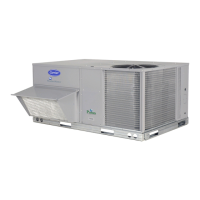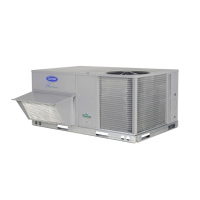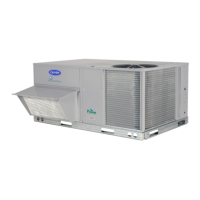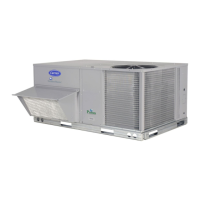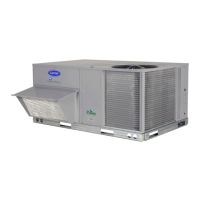39
LonWorks. Switch 3 (SW3) on the board is used to set
protocol and baud rate. Switches 1 and 2 (SW1 and SW2)
are used to set the board’s network address. See Fig. 62
and 63 for protocol switch settings and address switches.
The third party connection to the RTU Open controller is
through plug J19. See Fig. 64 for wiring.
NOTE: Power must be cycled after changing the SW1−3
switch settings.
Refer to the RTU Open v3 Integration Guide for more
detailed information on protocols, third party wiring, and
networking.
SW3 Protocol Selection
PROTOCOL DS8 DS7 DS6 DS5 DS4 DS3 DS2 DS1
BACnet MS/TP
(Master)
Unused OFF OFF OFF ON OFF Select Baud Select Baud
Modbus
(Slave)
Unused OFF OFF ON ON OFF Select Baud Select Baud
N2
(Slave)
Unused OFF OFF OFF ON ON OFF OFF
LonWorks Unused ON ON OFF ON OFF OFF ON
NOTE:
DS = Dip Switch
BACnet MS/TP SW3 example shown
Baud Rate Selections
BAUD RATE DS2 DS1
9600 OFF OFF
19,200 ON OFF
38,400 OFF ON
76,800 ON ON
C07166
Fig. 62 − RTU Open SW3 Dip Switch Settings
C10815
Fig. 63 − RTU Open Address Switches
C10816
Fig. 64 − Network Wiring
Local Access
Wall Mounted Equipment Toucht Interface
The Equipment Touch interface is a wall mounted
interface used to connect to the RTU Open controller to
access the control information, read sensor values, and
maintenance. This is an accessory interface that does not
come with the RTU Open controller. You wire the
Equipment Touch interface to the RTU Open controller’s
J13 local access port. There are 2 password protected
levels in the display (User and Admin). See the
Equipment Touch Installation and Setup Guide for more
information. See Appendix A for navigation and screen
content.
Field Assistant
Field Assistant is a computer program included with the
purchase of the Tech Tool Kit (USB-TKIT). This is a field
Tech Tool to set-up, service, or download application
software to the RTU Open controller and includes a USB
Link Cable. The link cable connects a USB port to the J12
local access port. The Field Assistant’s menu structure is
similar and functions the same as i−Vu
R
controller. See
Fig. 65.
RTU Open Controller Troubleshooting —
Communication LEDs: The LEDs indicate if the
controller is speaking to the devices on the network. The
LEDs should reflect communication traffic based on the
baud rate set. The higher the baud rate the more solid the
LEDs will appear. See Table 14.
50HCQ

